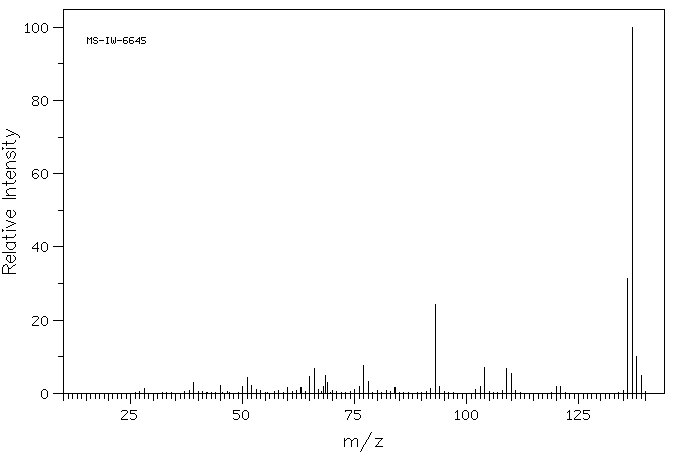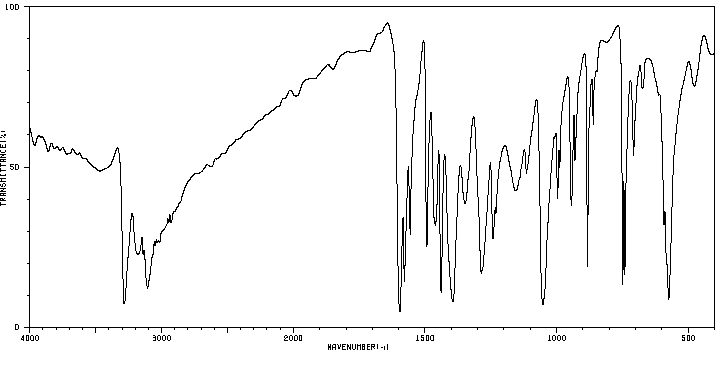1-氨基-1,3,5-环庚三烯-7-硫酮 | 3336-99-0
中文名称
1-氨基-1,3,5-环庚三烯-7-硫酮
中文别名
——
英文名称
2-aminotropothione
英文别名
2-aminocyclohepta-2,4,6-triene-1-thione
CAS
3336-99-0
化学式
C7H7NS
mdl
MFCD19203595
分子量
137.205
InChiKey
PPLLQJLYBBNMOD-UHFFFAOYSA-N
BEILSTEIN
——
EINECS
——
-
物化性质
-
计算性质
-
ADMET
-
安全信息
-
SDS
-
制备方法与用途
-
上下游信息
-
文献信息
-
表征谱图
-
同类化合物
-
相关功能分类
-
相关结构分类
计算性质
-
辛醇/水分配系数(LogP):1.7
-
重原子数:9
-
可旋转键数:0
-
环数:1.0
-
sp3杂化的碳原子比例:0.0
-
拓扑面积:58.1
-
氢给体数:1
-
氢受体数:2
反应信息
-
作为反应物:描述:1-氨基-1,3,5-环庚三烯-7-硫酮 在 盐酸 作用下, 以 乙醇 、 苯 为溶剂, 反应 7.0h, 生成 2-(4-Chloro-phenyl)-3H-1-thia-2a-aza-cyclopenta[cd]azulene-3,4-dicarboxylic acid dimethyl ester参考文献:名称:2-Aryl-2H-环庚噻唑与乙炔二甲酸二甲酯的反应摘要:2-芳基-2H-环庚噻唑与乙炔二甲酸二甲酯反应得到2-芳基-3H-1-thia-2a-氮杂环戊[cd]azulene-3,4-二甲酸二甲酯,6-苯基-2,3,4,5四甲酯-吡啶四羧酸酯和5-[(硫代芳酰基)亚氨基甲基]-1,2,3,4-萘四羧酸四甲酯。DOI:10.1246/bcsj.60.1201
-
作为产物:描述:2-氨基-2,4,6-环庚三烯-1-酮 在 diphosphorus pentasulfide 、 三乙胺 作用下, 以 乙腈 为溶剂, 反应 3.0h, 以63%的产率得到1-氨基-1,3,5-环庚三烯-7-硫酮参考文献:名称:General Synthesis, Spectroscopic Properties, and Dipole Moments of 2-Substituted Tropothiones摘要:几种具有电子给体基团(如甲基、苯基、氨基、甲氨基、羟基、甲氧基或硫甲基)的2-取代类萜烯硫酮(2,4,6-环七烯-1-硫酮)通过从相应的类萜酮直接硫化反应合成,采用一锅法。在与不稳定的母体类萜烯硫酮(1a)相比,这些大多数2-取代衍生物对空气不敏感,并且是热稳定化合物,可以在室温下处理。这些类萜烯硫酮衍生物通过光谱和偶极矩测量进行了表征。红外光谱显示在约1100—1040 cm−1处有ν(C=S)的振动。紫外-可见光谱显示伴随n–π*跃迁的三个π–π*跃迁。400-MHz的1H NMR光谱显示,仅有7位的质子因强C=S各向异性而与其他环上的质子分开共振。13C NMR(100.6 MHz)光谱中,C=S碳信号出现在< δ = 183,其他环碳的共振在δ = 154—112。变温13C和14N NMR光谱研究表明,2-氨基和2-(甲氨基)类萜烯硫酮以大约64 : 36的比例存在于硫酮与烯硫醇结构的平衡混合物中。这与之前的研究结果不同,后者表明这些结构仅存在于硫酮形态。对一些1a衍生物的偶极矩进行了测量,并与相应类萜酮的偶极矩进行了比较。这些获得的类萜烯硫酮衍生物比母体化合物1a和相应类萜酮更具离子性。DOI:10.1246/bcsj.66.3699
文献信息
-
Studies on Seven-membered Ring Compounds. XX. Reactions of Troponeimine Derivatives. (2)作者:Hideo Nakao、Nobuo Soma、Genshun SunagawaDOI:10.1248/cpb.13.828日期:——The reaction of 2-methoxytroponeimine (I) and its N-methyl derivative (II) with active methylene compounds were carried out. The reaction of I with malononitrile, ethyl cyanoacetate or cyanoacetamide in the presence of sodium ethoxide afforded rearrangemet products, that is 3-phenylacrylic acid derivatives. The same reaction in the absence of sodium ethoxide gave mainly 2-imino-1, 2-dihydrocyclohepta[b]pyrrole derivatives. However, the reaction of I with diethyl malonate afforded ethyl 2-oxo-8-methoxy-1, 2-dihydrocyclohepta[b]pyrrole-3-carboxylate. II showed some different reactivity from I. Namely, the reaction of II with active methylene compounds in the presence of sodium ethoxide afforded 2-imino-1, 2-dihydrocyclohepta[b]pyrrole derivatives besides rearrangement products.
-
Conductive Salts of Tropylium Ions with Tetracyanoquinodimethan Anion Radical (TCNQ<sup>\ewdot</sup>) and Bisthiadiazolotetracyanoquinodimethan Anion Radical (BTDA–TCNQ<sup>\ewdot</sup>)作者:Yoshiro Yamashita、Koji Hagiya、Gunzi Saito、Toshio MukaiDOI:10.1246/bcsj.61.271日期:1988.1Tropylium ions have been found to be good cations for forming highly conductive salts of TCNQ\ewdot. Tropylium ions with different reduction potentials were prepared. The first reduction potentials which are correlated with the substituent constants σp+ control the formation of the salts. The cations with higher reduction potentials underwent a reaction with TCNQ\ewdot to give neutral TCNQ and coupling已发现 Tropylium 离子是用于形成 TCNQ\ewdot 的高导电盐的良好阳离子。制备了具有不同还原电位的托鎓离子。与取代基常数σp+相关的第一还原电位控制盐的形成。具有较高还原电位的阳离子与 TCNQ\ewdot 发生反应,得到中性 TCNQ 和偶联产物。最初形成的盐的摩尔比也取决于还原电位。仅当还原电位低于 -0.43 V 时才形成简单的盐。这一事实是由于电子从 TCNQ\ewdot 到由还原电位决定的 tropylium 离子转移的难易程度不同而合理化的。与通常的 TCNQ\ewdot 简单盐相比,一些简单的盐显示出显着低的电阻率。BTDA-TCNQ\ewdot 还提供了 tropylium 离子的导电盐,表明 BTDA-TCNQ 可用于形成有机半导体。
-
Gmelin Handbuch der Anorganischen Chemie, Gmelin Handbook: Ni: MVol.C2, 8.13, page 963 - 978作者:DOI:——日期:——
-
Machiguchi, Takahisa; Kano, Yuichi; Hasegawa, Toshio, Chemistry Letters, 1990, # 4, p. 563 - 566作者:Machiguchi, Takahisa、Kano, Yuichi、Hasegawa, ToshioDOI:——日期:——
-
1-Amino-7-thioxo-1,3,5-cycloheptatrienes作者:W. R. Brasen、R. E. BensonDOI:10.1021/ja01475a032日期:1961.7
表征谱图
-
氢谱1HNMR
-
质谱MS
-
碳谱13CNMR
-
红外IR
-
拉曼Raman
-
峰位数据
-
峰位匹配
-
表征信息
同类化合物
(乙腈)二氯镍(II)
(R)-(-)-α-甲基组胺二氢溴化物
(N-(2-甲基丙-2-烯-1-基)乙烷-1,2-二胺)
(4-(苄氧基)-2-(哌啶-1-基)吡啶咪丁-5-基)硼酸
(11-巯基十一烷基)-,,-三甲基溴化铵
鼠立死
鹿花菌素
鲸蜡醇硫酸酯DEA盐
鲸蜡硬脂基二甲基氯化铵
鲸蜡基胺氢氟酸盐
鲸蜡基二甲胺盐酸盐
高苯丙氨醇
高箱鲀毒素
高氯酸5-(二甲氨基)-1-({(E)-[4-(二甲氨基)苯基]甲亚基}氨基)-2-甲基吡啶正离子
高氯酸2-氯-1-({(E)-[4-(二甲氨基)苯基]甲亚基}氨基)-6-甲基吡啶正离子
高氯酸2-(丙烯酰基氧基)-N,N,N-三甲基乙铵
马诺地尔
马来酸氢十八烷酯
马来酸噻吗洛尔EP杂质C
马来酸噻吗洛尔
马来酸倍他司汀
顺式环己烷-1,3-二胺盐酸盐
顺式氯化锆二乙腈
顺式吡咯烷-3,4-二醇盐酸盐
顺式双(3-甲氧基丙腈)二氯铂(II)
顺式3,4-二氟吡咯烷盐酸盐
顺式1-甲基环丙烷1,2-二腈
顺式-二氯-反式-二乙酸-氨-环己胺合铂
顺式-二抗坏血酸(外消旋-1,2-二氨基环己烷)铂(II)水合物
顺式-N,2-二甲基环己胺
顺式-4-甲氧基-环己胺盐酸盐
顺式-4-环己烯-1.2-二胺
顺式-4-氨基-2,2,2-三氟乙酸环己酯
顺式-3-氨基环丁烷甲腈盐酸盐
顺式-2-羟基甲基-1-甲基-1-环己胺
顺式-2-甲基环己胺
顺式-2-(苯基氨基)环己醇
顺式-2-(苯基氨基)环己醇
顺式-2-(氨基甲基)-1-苯基环丙烷羧酸盐酸盐
顺式-1,3-二氨基环戊烷
顺式-1,2-环戊烷二胺二盐酸盐
顺式-1,2-环戊烷二胺
顺式-1,2-环丁腈
顺式-1,2-双氨甲基环己烷
顺式--N,N'-二甲基-1,2-环己二胺
顺式-(R,S)-1,2-二氨基环己烷铂硫酸盐
顺式-(2-氨基-环戊基)-甲醇
顺-2-戊烯腈
顺-1,3-环己烷二胺
顺-1,3-双(氨甲基)环己烷








